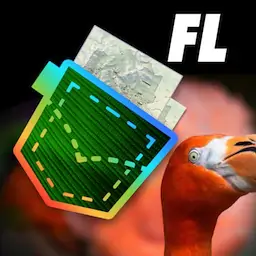"Sunset over the preserve, Big Cypress National Preserve, 2015." by U.S. National Park Service , public domain
Red-Cockaded WoodpeckerBig Cypress |
featured in
| National Parks Pocket Maps |  | |
| Florida Pocket Maps |  |
Big Cypress
The Red-cockaded Woodpecker
National Park Service
U.S. Department of the Interior
Big Cypress
National Preserve
Photo courtesy of Ralph Arwood, NPS/VIP
The endangered Red-cockaded Woodpecker is a “keystone” species that reflects the health of its southern forest home, the same
home vital to deer, turkey, panthers and people. The Red-cockaded Woodpecker struggles to find older pines in territories not
fragmented by development. The Slash pine (Pinus elliottii) ecosystem in which it thrives has been reduced by 97 percent, and
many populations of the woodpecker continue to decline. Big Cypress National Preserve contains many healthy stands of Slash
pines that also support this unique bird.
W
hat does “home” mean to you? For the Redcockaded Woodpecker (Picoides borealis), the
ideal home is in an old longleaf pine tree that is between
64 to 149 years of age! Old living pines desired by the
woodpeckers have thinner sapwood and more heartwood
than other pines. Surveys in 1979 and 1980 revealed Big
Cypress National Preserve supports a population of Redcockaded Woodpeckers, a federally-listed endangered
species. Pine forests found within the Preserve constitute
an ideal roosting and nesting area for the birds. These
forests have little understory growth, primarily due to fires
and seasonal flooding.
Building a Home
Did you know that the Red-cockaded Woodpecker is
the only North American woodpecker that roosts and
excavates its nest in living trees? The woodpecker builds
its home or cavity by carving out a hole with its bill like
a construction worker using a jackhammer to break up
cement. Holes drilled into the pine are constructed at an
upward angle to prevent rain from entering the chamber.
The birds remove bark from around their cavity to make it
smooth and encourage resin wells from the sap of the tree to
form around the hole. The slippery sap from the resin wells
help keep out predators or unwanted neighbors, such as rat
snakes. Cavities can be drilled in a matter of months, but
one to three years is more typical. Preferring open areas,
Red-cockaded Woodpeckers will abandon their homes if
bushy vegetation reaches 15 feet or higher near the tree.
Starting a New Family
Typically a Red-cockaded Woodpecker can begin breeding
at one year of age. The best nesting success rates occur from
late April through June. Clutch size is between two to four
eggs. Incubation takes 10-11 days. Young woodpeckers
fledge in 28-29 days and are dependent on their family for
survival until they are two to five months old. Frequently
within the year the young female birds, also known as
“floaters,” fledge or leave the nest. “Floaters” look to start
their own families by joining a Red-cockaded Woodpecker
group searching for a female “floater” to complete a
breeding pair.
Red-cockaded Woodpecker Identification
•R
elatively slender, long-tailed, and small-billed.
• Adult length 8.5”, wingspan 14”, weight 1.5oz (44 g).
Males slightly bigger.
•W
hite cheek patches, black cap and neck, black and
white barred back wings.
• Males have a few red feathers above and behind the eyes,
the “cockade.” Red is covered with black feathers so not
readily seen. Females do not have any red on them
• Immature males have a red “patch” in the center of their
black crown on heads.
What is on the Food Menu?
Red-cockaded Woodpeckers feed on what they can find
by picking away at the bark on trees or by capturing flying
insects. The woodpeckers also feed on vegetation. Specials
that could be featured on the Red-cockaded Woodpecker
menu include larvae, beetles, ants, roaches, and spiders.
Male Red-cockaded Woodpeckers often feed near tree tops
while females eat lower on the trees. Perhaps this feeding
in different areas of the tree helps prevent the breed from
being in competition with one another when food sources
are low.
Survival
The areas where Red-cockaded Woodpeckers live are
threatened by habitat loss, fragmentation, and lack of fire
or infrequent fire that maintains habitat quality in Florida.
Although South Florida is not a designated recovery
population for Red-cockaded Woodpeckers, the area
contains significant support populations for recovery
of the species in the southeast. Eighty-one percent of
South Florida’s Red-cockaded woodpecker colonies have
successfully produced young.
Help for the Red-cockaded Woodpecker can be provided.
One way is by continuing to support survey projects
conducted for the Red-cockaded Woodpecker. Also
providing snags can be important. Snags are trees that
are decaying or dead. Providing snags will give other
woodpeckers a place to live so they won’t be competing
against the Red-cockaded Woodpeckers for live trees. In
addition to saving snags, conserving “starts” is another
way to support the Red-cockaded Woodpecker. “Starts”
are incomplete holes or cavities in a tree. These incomplete
homes may have been started by a woodpecker or created
artificially with the idea it might become a woodpecker
dwelling. Lastly, land managers can control the height of
understory by setting prescribed fires every three to five
years outside of the woodpeckers’ nesting season.
NPS/Garnet Tritt
Family Tree
It takes many birds with unique family roles to help
create an individual woodpecker’s family tree. The Redcockaded Woodpecker is a territorial (non-migratory)
bird. Its cooperative social clan or family consists of a pair
of breeding birds (a pair that stays together until one dies)
and three helpers. “Helpers” are typically immature males
usually from the breeding pair of the previous year. Helpers
defend the cavity territory and help with feeding the young
nesting birds while living in their own cavities. The birds
nest and forage together in a “cluster” or group of active
cavity trees forming a colony.
Firefighters start prescribed
fires to burn trees and shrubs
at the mid-story level. This
clears more foraging space for
Red-cockaded Woodpeckers
along the slash pine trees.
Did you know?
A cockade is a ribbon or feather worn on the side of a hat.
The Red-cockaded Woodpecker gets its name from the red
feathers located on the side of male woodpeckers’ heads
(see the picture below).
References
Birds of North America, Jackson, J.A., 1994.
U.S. Fish and Wildlife Safe Harbor Agreement: www.fws.gov/endangered/
recovery/harborqa.pdf
US Fish and Wildlife Service, South Florida Multi Species Recovery Plan, Red
Cockaded Woodpecker: http://www.fws.gov/verobeach/Programs/Recovery/
vbms4.html
U.S. Fish & Wildlife Service: http://www.fws.gov
Photo courtesy of Ralph Arwood, NPS/VIP
A male Red-cockaded Woodpecker with the hard to see, but identifying cockade.
EXPERIENCE YOUR AMERICA
Red Cockaded Woodpecker_FINAL.indd on HQ shareall, interp publications: 4,000 printed 10/2010, stored at Oasis & WC


